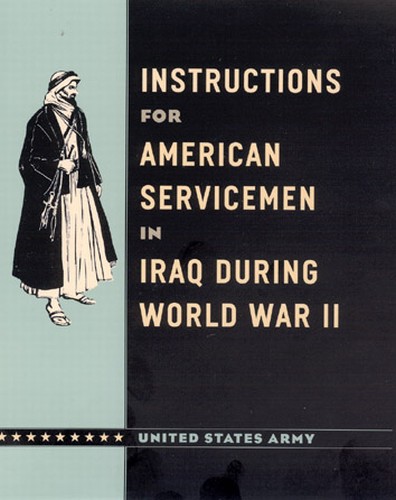Getting along in Iraq
 The United States Army’s Instructions for American Servicemen in Iraq during World War II has been drawing quite a bit of attention this week. With two reviews in the Washington Post, a web-exclusive article on MSNBC’s Newsweek website, and a discussion about the book with Lt. Colonel John Nagl, (author of the new foreword), posted to Dwight Garner’s Paper Cuts blog at the New York Times, this small handbook has everyone wondering why it wasn’t discovered sooner. Originally issued to soldiers serving in Iraq during WWII, the book contains both practical and diplomatic advice that, to many, seems highly relevant to the current conflict in Iraq. Columnist Al Kamen writes for the Washington Post:
The United States Army’s Instructions for American Servicemen in Iraq during World War II has been drawing quite a bit of attention this week. With two reviews in the Washington Post, a web-exclusive article on MSNBC’s Newsweek website, and a discussion about the book with Lt. Colonel John Nagl, (author of the new foreword), posted to Dwight Garner’s Paper Cuts blog at the New York Times, this small handbook has everyone wondering why it wasn’t discovered sooner. Originally issued to soldiers serving in Iraq during WWII, the book contains both practical and diplomatic advice that, to many, seems highly relevant to the current conflict in Iraq. Columnist Al Kamen writes for the Washington Post:
As the war in Iraq drags on, some folks talk about wishing everyone knew in 2003 what we know now. Turns out, we did.
The surprise hit book of this summer may well be a 44-pager by an unknown War Department writer in 1943 titled: Instructions for American Servicemen in Iraq During World War II.
On the very first page, we learn that “American success or failure in Iraq may well depend on whether the Iraqis (as the people are called) like American soldiers or not. It may not be quite that simple. But then again it could.…”
Army Lt. Col. John A. Nagl, who commands the 1st Battalion, 34th Armor Regiment, at Fort Riley, Kan., said he wished he’d read the guide before his unit deployed to Anbar province in 2003. It’s “particularly good on religious customs and courtesies that bedeviled my unit,” he wrote in the foreword to the guide.…
Nagl photocopies and distributes parts of the guide for soldiers deploying to Iraq. There are other Pentagon primers on Iraq, he said, but “none were as charming and enjoyable as this … happy little book. It would be harder to come up with a better read for those going to Iraq. This is a book to help you live among the people,” and “that is the strategy Gen. Petraeus is implementing.”
To read the rest of the article navigate to the Washington Post website (you might have to login to read). Also see the Paper Cuts posting or the web-exclusive in Newsweek, where you can view several illustrated excerpts from the book.